Weeding garden beds can be a pain, particularly if you’re struggling with invasive plants like Japanese knotweed and garlic mustard. Hand-pulling these noxious plants and smothering them out with mulch or weed barrier fabrics can help, but if you’re not diligent, weeds and invasives will often creep back into your garden. One way to stop this from happening is to grow fast-growing groundcovers or plant sturdy native plants that grow faster than the weeds do!
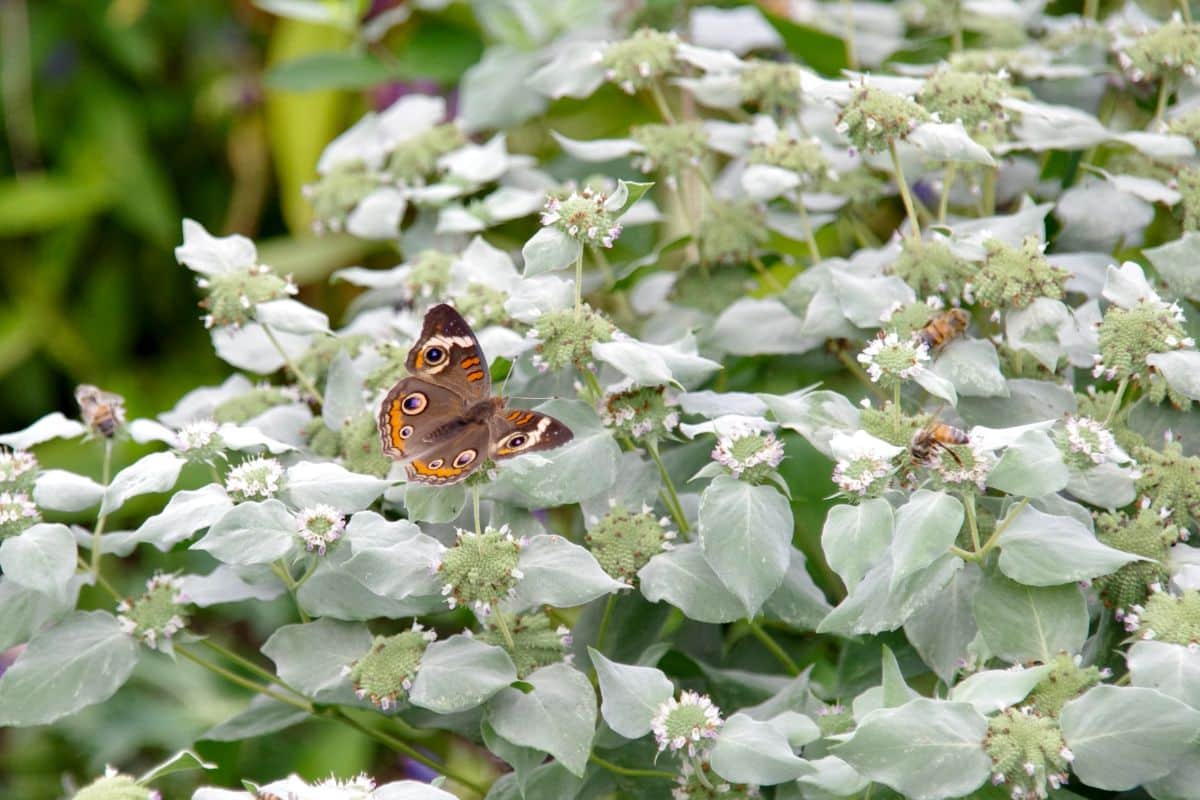
In this guide, you’ll find 18 of the most robust and fastest-growing native North American plants. These plants can naturally smother out weeds and unwanted grasses, but some of these stalwart natives can also help keep invasive plants in check. If you keep a no-dig garden or you just love native plants, this guide is for you!
Jump to:
- 18 fast-growing native plants that can outcompete weeds and invasives
- 1. Black-eyed Susan (Rudbeckia hirta)
- 2. Joe Pye weed (Eutrochium purpureum)
- 3. Sumac (Rhus spp.)
- 4. Bee balm (Monarda fistulosa)
- 5. Golden ragwort (Packera aurea)
- 6. Mountain mint (Pycnanthemum virginianum)
- 7. Elderberry (Sambucus spp.)
- 8. Virginia creeper (Parthenocissus quinquefolia)
- 9. Lady fern (Athyrium filix-femina)
- 10. Gray dogwood (Cornus racemosa)
- 11. Celandine poppy (Stylophorum diphyllum)
- 12. Blue mistflower (Conoclinium coelestinum)
- 13. Pennsylvania sedge (Carex pensylvanica)
- 14. Wild ginger (Asarum canadense)
- 15. Big leaf aster (Eurybia macrophylla)
- 16. Northern bush honeysuckle (Diervilla lonicera)
- 17. Jewelweed (Impatiens capensis)
- 18. Goldenrod (Solidago spp.)
- Summary
18 fast-growing native plants that can outcompete weeds and invasives

North America has many incredible species of native plants, including buttonbushes, irises, vervain, blueberries, and ironweed. However, if your goal is to keep invasive plants in line, you’ll want to select fast-growing native plants that can outcompete invasives and weeds. Below are some of our favorite native plant options for North American growers, but feel free to explore native plant lists for your specific growing region to find more planting suggestions!
1. Black-eyed Susan (Rudbeckia hirta)
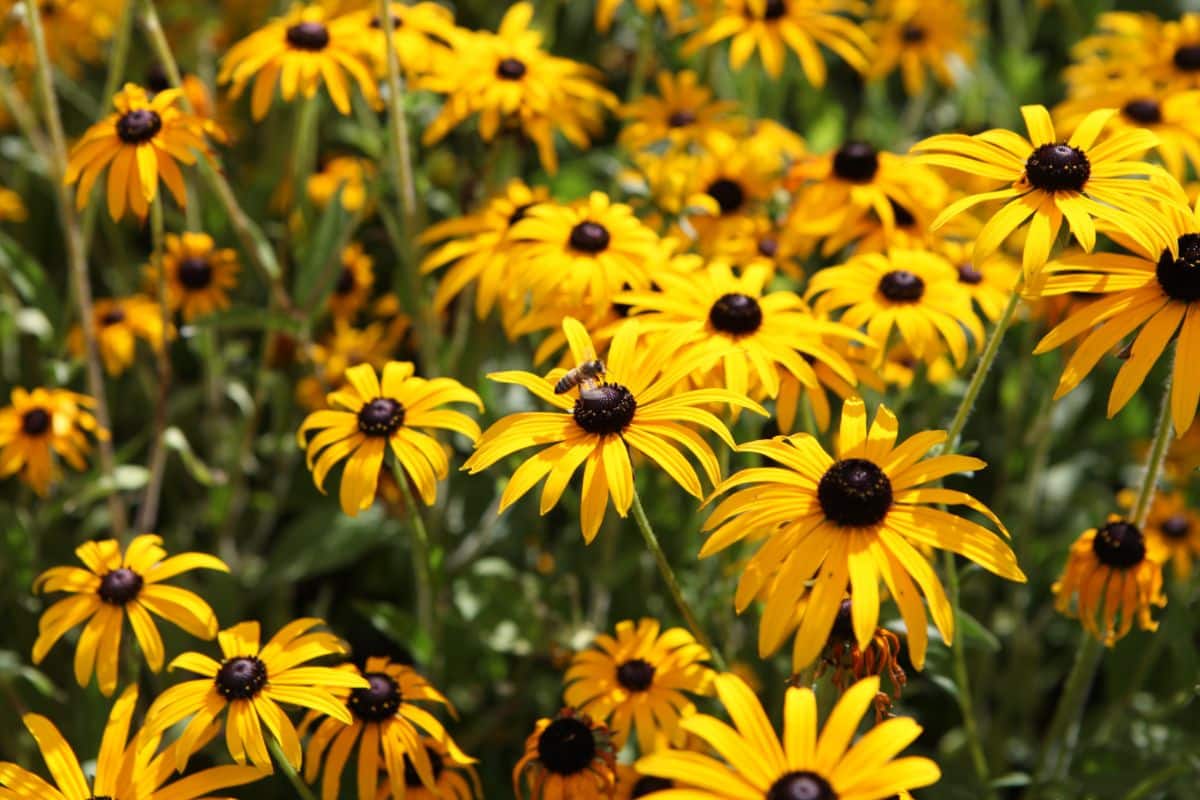
| Plant name: | Black-eyed Susan |
| Light requirements: | Full sun to part shade |
| Water requirements: | Moderate |
| Growing zone: | Zones 3 to 9 |
| Recommended against: | Various weeds and grasses |
Black-eyed Susan plants are found throughout North America, but they’re particularly common along the eastern coast. Known for their cheery, golden-orange petals and chocolatey brown centers, black-eyed Susan are popular choices in cottage gardens and other ornamental garden designs, but they’re also fantastic pollinator plants. Late in the season, black-eyed Susans also produce loads of protein-packed seeds, which provide much-needed nourishment for birds in winter.
While black-eyed Susan may look delicate, these plants grow rapidly, and they are also prolific self-sowers. Planting these beauties in your garden will add extra color to your landscape, but fast-growing black-eyed Susans may also outcompete lower-growing weeds and unwanted grasses. In fact, black-eyed Susan are such easy-going plants they are sometimes even used as a grass alternative for wildflower lawns!
2. Joe Pye weed (Eutrochium purpureum)
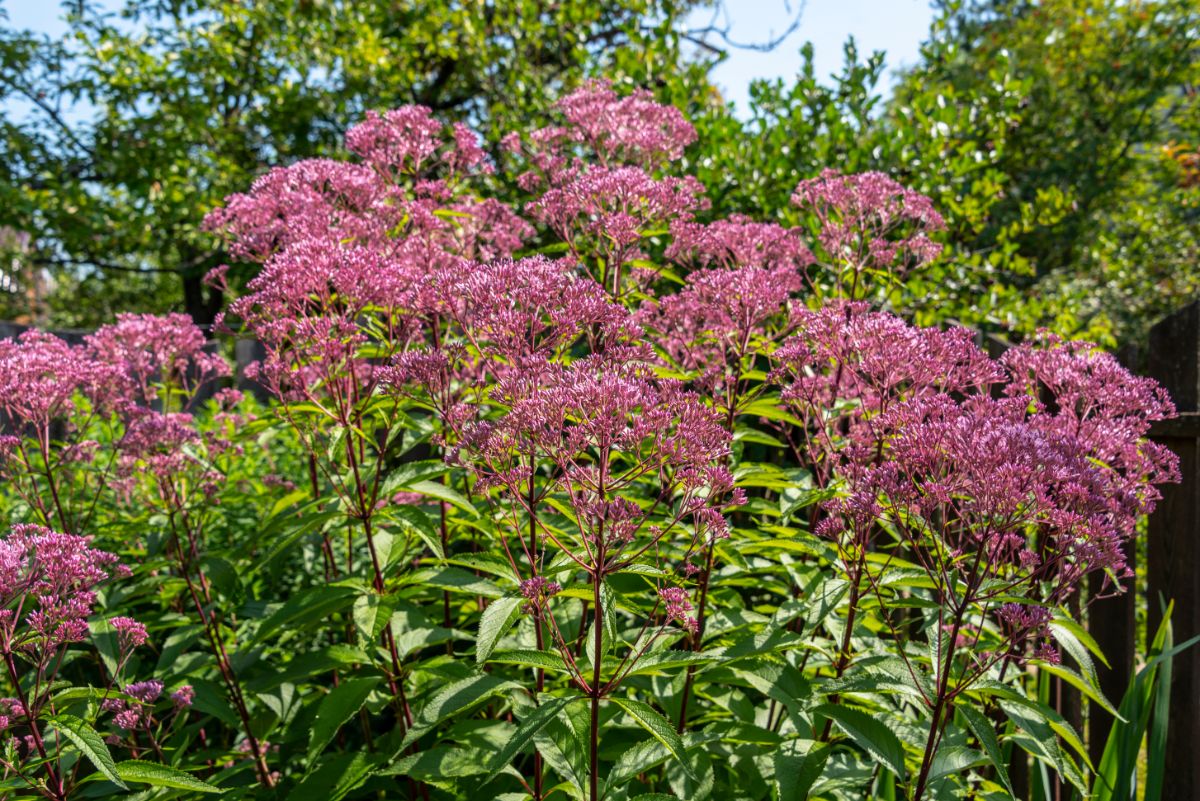
| Plant name: | Joe Pye weed |
| Light requirements: | Full sun to part shade |
| Water requirements: | High |
| Growing zone: | Zones 4 to 8 |
| Recommended against: | Various weeds and grasses |
Mighty Joe Pye weed is a beast of a plant that grows quickly and can stretch over 6’ tall when mature. If you’re looking for a tough plant that will keep weeds and invasives in check, this pollinator-friendly plant may do the trick. And Joe Pye weed looks pretty while doing it, too!
Joe Pye weed thrives in moist areas, and it’s commonly found growing wild along pond margins and stream banks. In the garden, Joe Pye weed will need to be watered often, but it can also be planted in soggy sections of your property. When it flowers at the end of summer to early fall, Joe Pye weed’s broad, flat blooms become magnets for butterflies and other beneficial insects.
3. Sumac (Rhus spp.)
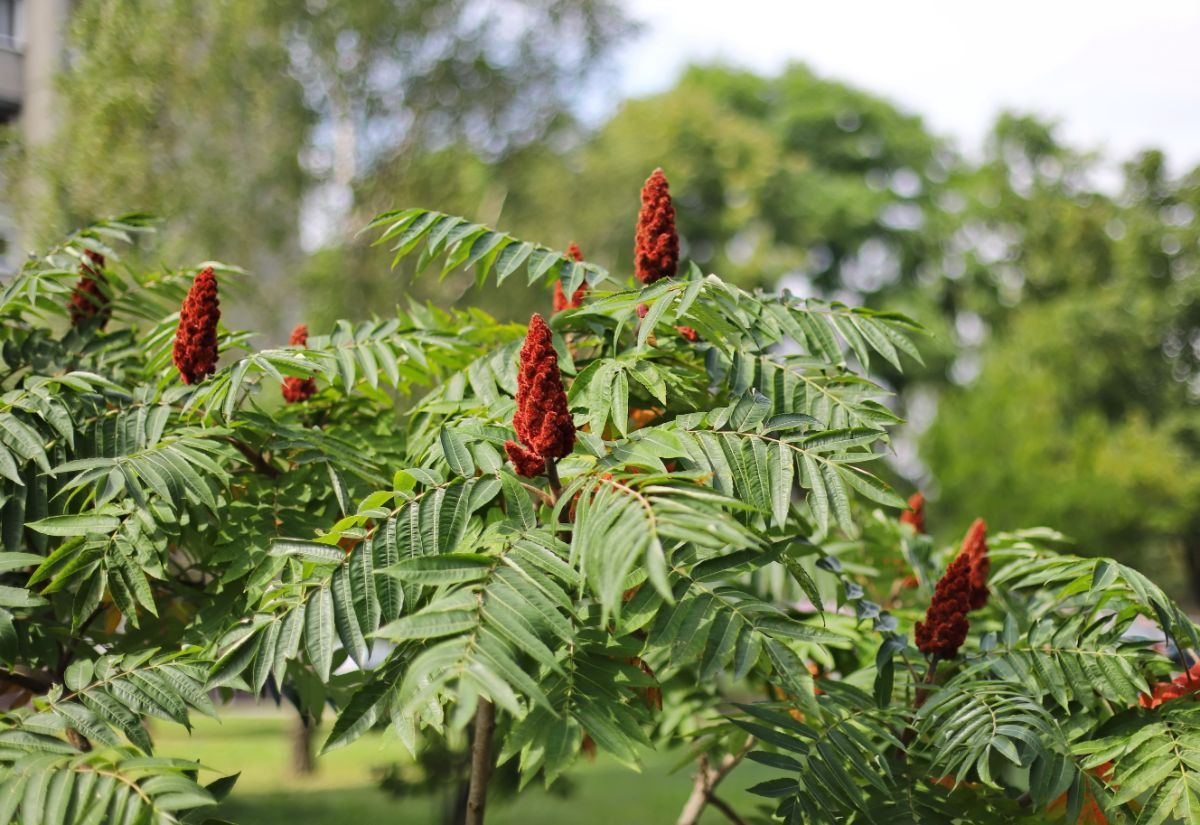
| Plant name: | Sumac |
| Light requirements: | Full sun to part shade |
| Water requirements: | Moderate |
| Growing zone: | Zones 3 to 9, most species |
| Recommended against: | Tree of heaven, Japanese knotweed |
There are many different types of sumac, and some sumac varieties are not desirable additions to garden designs. For instance, poison sumac (Toxicodendron vernix) is a skin irritant, and it can give you a nasty rash if you brush up against it! However, many sumac species are perfectly safe, and some of them are even edible.
When it comes to keeping weeds and invasives at bay, fragrant sumac (Rhus aromatica) and staghorn sumac (Rhus typhina) are two fantastic native sumac choices. These plants produce edible berries that can be added to lemonade, but they’re also highly attractive to native songbirds. But even better, these sumac species grow so rapidly that they may even be able to outcompete aggressive invasive plants like Japanese knotweed and the tree of heaven (notoriously known as the host plant for the dreaded spotted lanternfly!)
4. Bee balm (Monarda fistulosa)
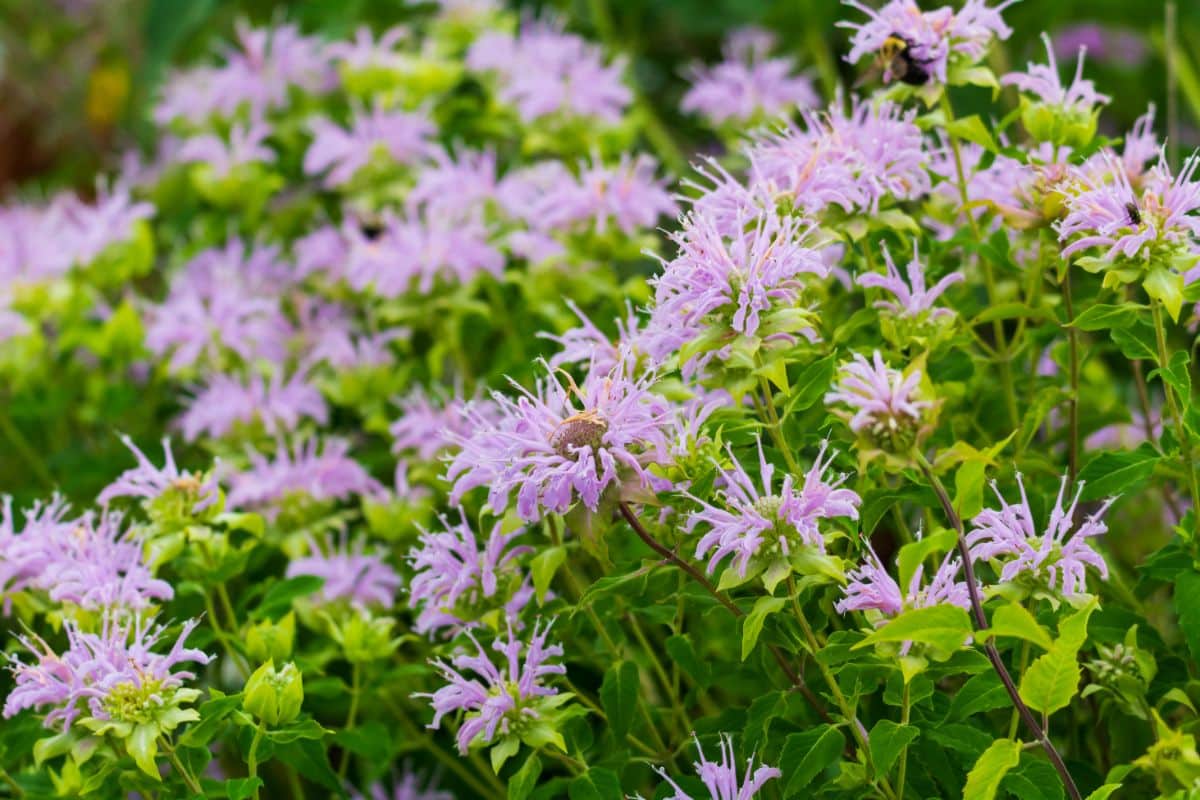
| Plant name: | Bee balm |
| Light requirements: | Full sun |
| Water requirements: | Moderate |
| Growing zone: | Zones 3 to 9 |
| Recommended against: | Various weeds and grasses |
Also known as wild bergamot, bee balm is an easygoing plant that’s often kept in pollinator gardens thanks to its nectar and pollen-rich flowers. Bee balm flowers and leaves are also edible, and they can be used as an herbal tea or dried and used as an alternative to oregano. But beyond their utility, bee balm plants are also bewitchingly beautiful, with spiky sprays of purple or pink flowers that look like miniature fireworks!
Bee balm comes in both tall and dwarf varieties, but if you’re interested in keeping weeds in check, you’ll probably want to stick with tall bee balm cultivars. Like other members of the mint family, bee balm grows and spreads rapidly, and it self-sows prolifically if you don’t deadhead spent blooms. Thanks to its vigorous nature, bee balm can easily outcompete many lower-growing weedy plants, meaning you may not have to do as much weeding if you keep bee balm around!
5. Golden ragwort (Packera aurea)
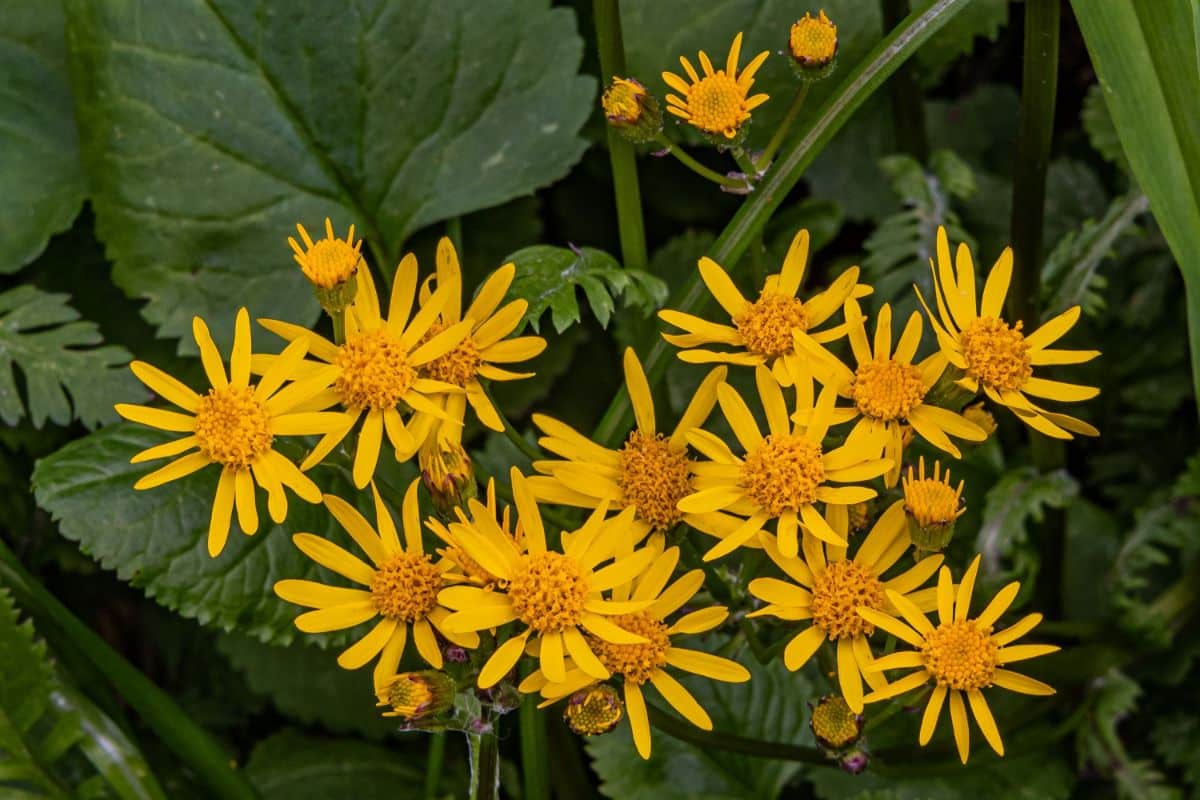
| Plant name: | Golden ragwort |
| Light requirements: | Full sun to part shade |
| Water requirements: | Moderate to low |
| Growing zone: | Zones 4 to 9 |
| Recommended against: | Garlic mustard and other weeds |
Golden ragwort looks a lot like goldenrod, which causes a fair amount of confusion in gardening circuits. However, these two plants are not closely related, although they do perform similar functions in the garden. Both plants are undeniably beautiful, but they’re also highly attractive to pollinators, and they can keep weeds and invasive in line, too!
When it comes to golden ragwort, this plant has shown some ability to suppress invasive garlic mustard, but it can also outcompete lower-growing weeds with ease. Part of this has to do with ragwort’s dense leaves, which shelter the soil and keep sunlight from reaching weed seeds. Just keep in mind that this plant can sometimes produce allergy symptoms, so you may want to avoid keeping it if you know you’re allergic to members of the Aster family.
6. Mountain mint (Pycnanthemum virginianum)
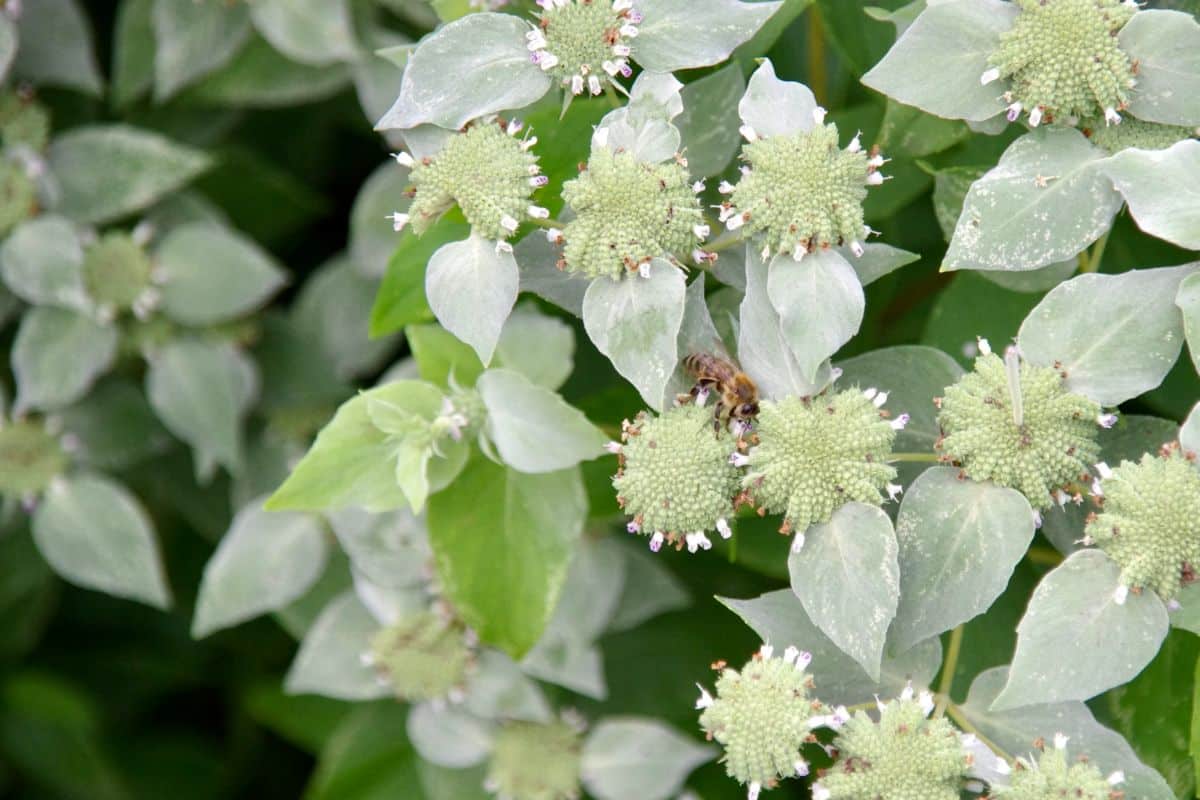
| Plant name: | Mountain mint |
| Light requirements: | Full sun to part shade |
| Water requirements: | High to moderate |
| Growing zone: | Zones 4 to 8 |
| Recommended against: | Various weeds and grasses |
Most gardeners are familiar with the aggressive growth of mint plants. Peppermint, spearmint, and even lemon balm can rapidly spread throughout gardens and choke out other less vigorous herbs and flowers. Because of this, some people are reluctant to plant mint at all, but there is a solution: grow mount mint!
Mountain mint is a North American native mint variety that doesn’t grow as aggressively as non-native mints. That said, mountain mint is a fast spread, and it can grow over 3’ tall by 3’ wide. These characteristics make mountain mint an impressive plant for suppressing weeds, and mountain mint flowers are also a favorite stopping spot for native bumblebees!
7. Elderberry (Sambucus spp.)
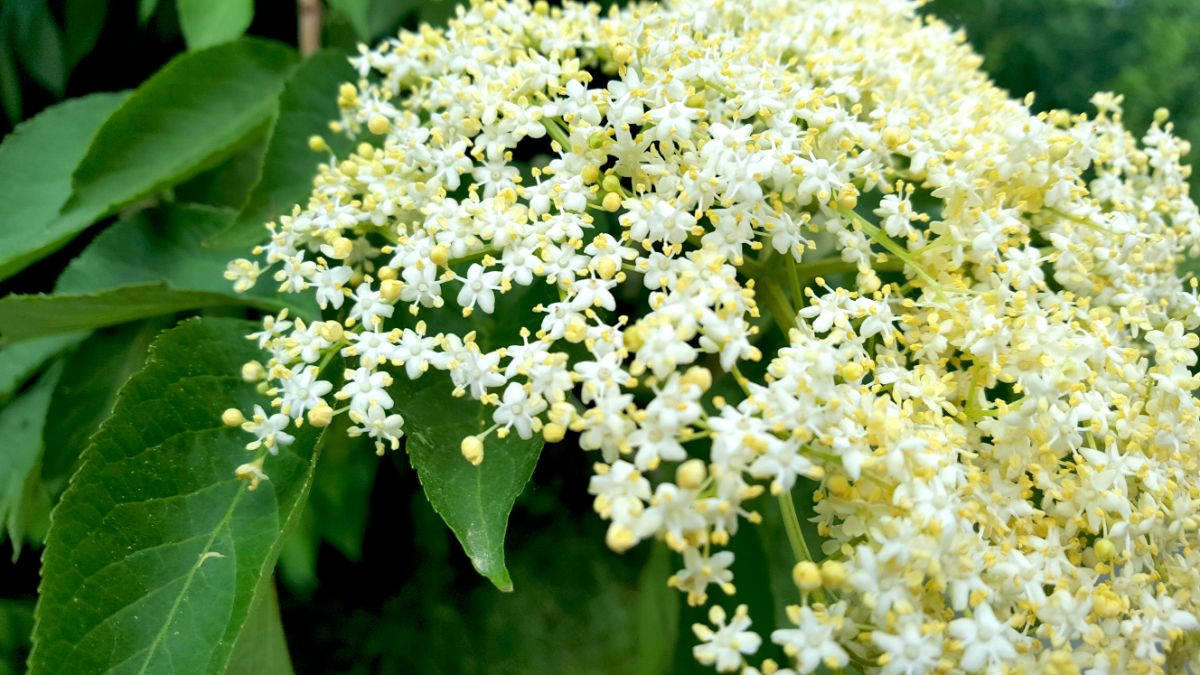
| Plant name: | Elderberry |
| Light requirements: | Full sun or part shade in very hot locations |
| Water requirements: | Moderate |
| Growing zone: | Zones 3 to 9 |
| Recommended against: | Various weeds and grasses |
Elderberry is mostly known as a medicinal plant, and its berries can be cooked into jams, jellies, and syrups. Earlier in the season, elderberry flowers function as beacons for pollinators in garden beds, but elderberry blooms can also be harvested and steeped into cocktails. Just be advised that elderberry plants contain cyanide, and elderberry flowers and berries need to be properly cooked before eating.
But while elderberry is certainly a fun plant to have around if you love concocting delicious brews in your kitchen, elderberry is also useful for suppressing weeds. Not only do elderberry shrubs have dense leaves, but they also grow over 1 to 2’ per year, meaning they can rapidly outgrow many noxious plants. Plus, elderberries are native to much of North America, and they thrive in shady spots where other plants may not take root.
8. Virginia creeper (Parthenocissus quinquefolia)
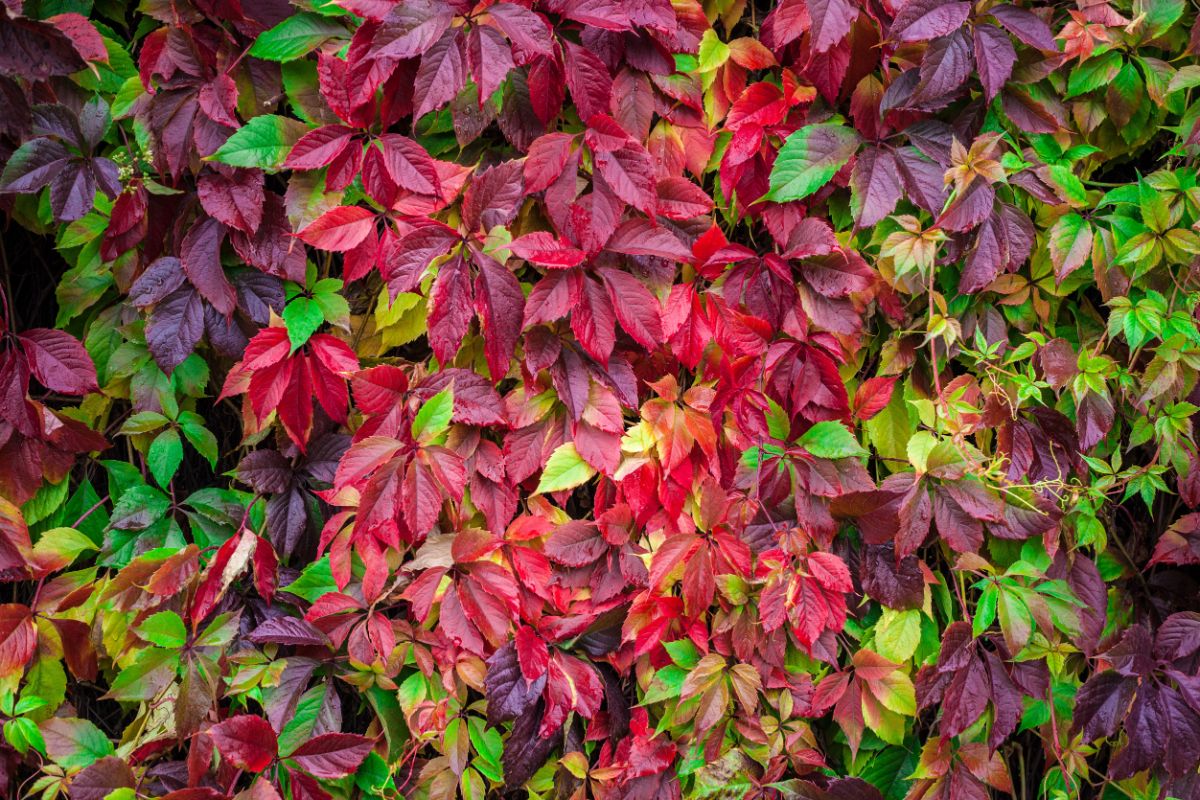
| Plant name: | Virginia creeper |
| Light requirements: | Full sun to shade |
| Water requirements: | Moderate to low |
| Growing zone: | Zones 3 to 9 |
| Recommended against: | Poison ivy, as well as certain weeds and grasses |
Some gardeners are reluctant to grow Virginia creeper as they confuse this plant with poison ivy. However, Virginia creeper has 5 leaves, and poison ivy has 3 leaves, and Virginia creeper is less likely to cause rashes (although it can cause skin reactions in sensitive individuals). Virginia creeper is also a top autumn foliage plant, as the leaves of this vining perennial blaze a brilliant shade of red when cold temperatures hit!
Virginia creeper is often grown on walls and fences for extra color, but it also makes a low-maintenance groundcover that can suppress many weeds. At times Virginia creeper can outcompete poison ivy, as well as low-growing invasive like garlic mustard. On top of that, Virginia creeper is an excellent pollinator plant, and it serves as a host plant for many species of Lepidoptera, including sphinx moths.
9. Lady fern (Athyrium filix-femina)
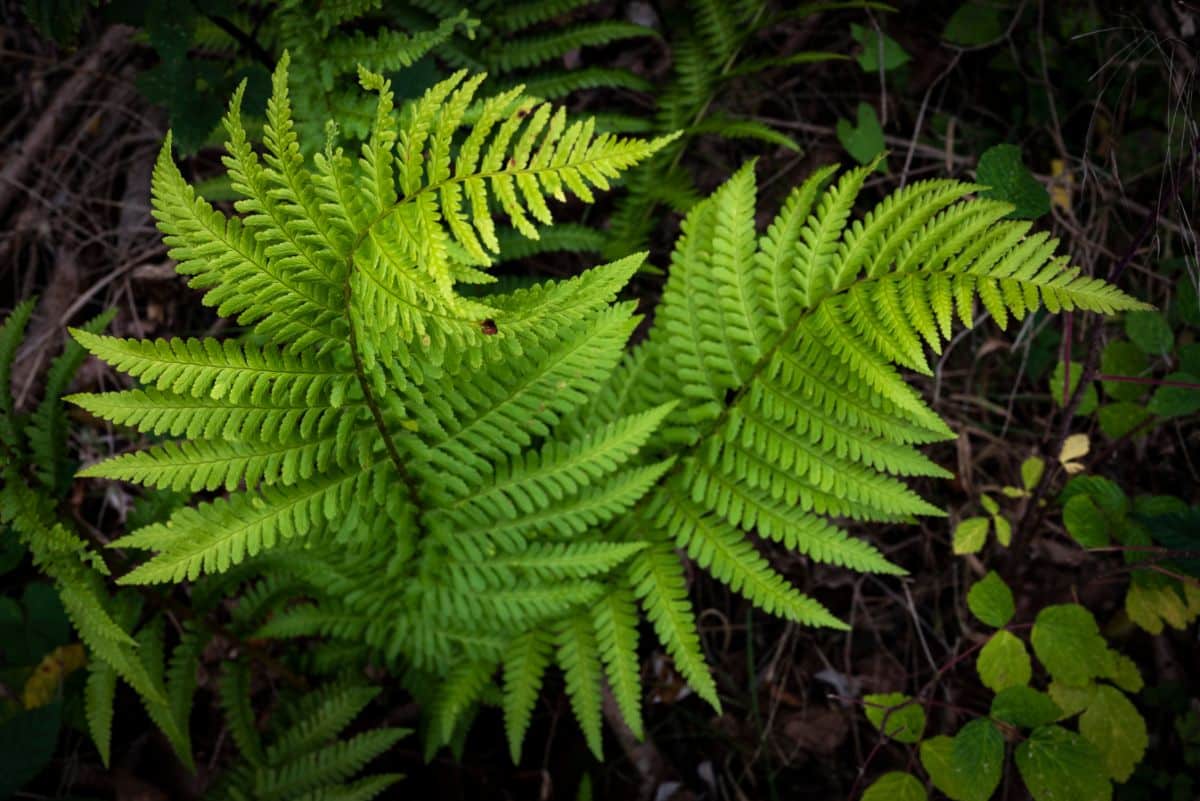
| Plant name: | Lady fern |
| Light requirements: | Shade |
| Water requirements: | High to moderate |
| Growing zone: | Zones 4 to 8 |
| Recommended against: | Various weeds and grasses |
There are many species of ferns that are native to North America, and lady fern is a particularly becoming option with feathery leaves that come in a bright green color. But don’t let lady fern’s delicate look fool you! This fern species is an impressive plant that grows and spreads quickly, and it can create a thick mat of leaves that’s difficult for weeds to penetrate in no time flat.
Compared to many of the other plants on this, lady fern thrives in lower light conditions, so it’s appropriate for shade gardens. But lady ferns can also tolerate part sun, and they are particularly well suited for gardens with moist and acidic soils. While you can grow lady ferns on their own, these plants will look best and provide the most weed protection if they’re grown in large groupings of at least 3 to 5 plants..
10. Gray dogwood (Cornus racemosa)
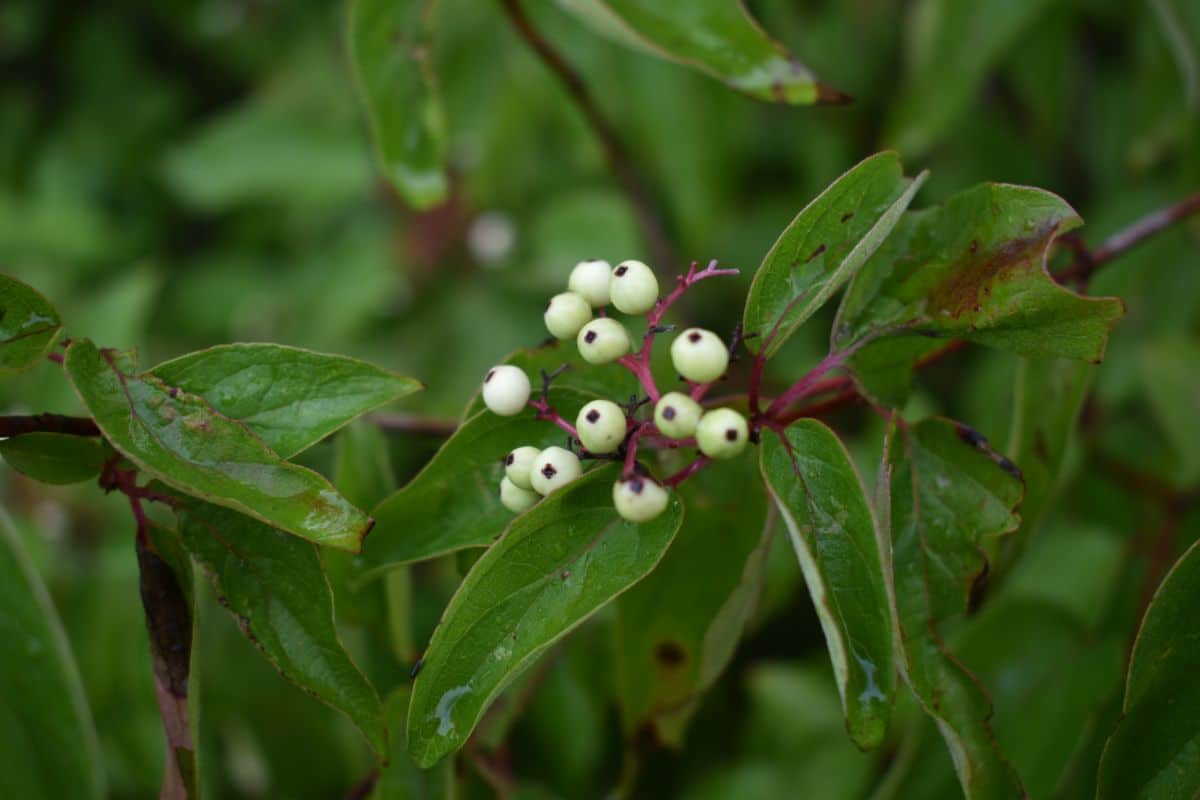
| Plant name: | Gray dogwood |
| Light requirements: | Full sun to part shade |
| Water requirements: | High to moderate |
| Growing zone: | Zones 4 to 8 |
| Recommended against: | Various weeds and grasses |
Many species of dogwood can be used to keep weeds down, but the gray dogwood is a particularly good option because it’s just so adaptable! Gray dogwood plants can tolerate difficult growing spots, like streambanks and gardens with soggy soil. And these plants can also spread quickly, forming dense thickets where weeds won’t find purchase.
Native to the central and eastern parts of Canada and the United States, gray dogwood is mostly grown for its white flowers and creamy white berries, which appear in late summer and attract birds. But gray dogwood can also be used as a pollinator or privacy plant, and it can grow over 12” per year. If you like the idea of using dogwood plants to keep weeds in line, you may also want to try out creeping dogwood (Cornus canadensis), which can be grown as a low-maintenance groundcover.
11. Celandine poppy (Stylophorum diphyllum)
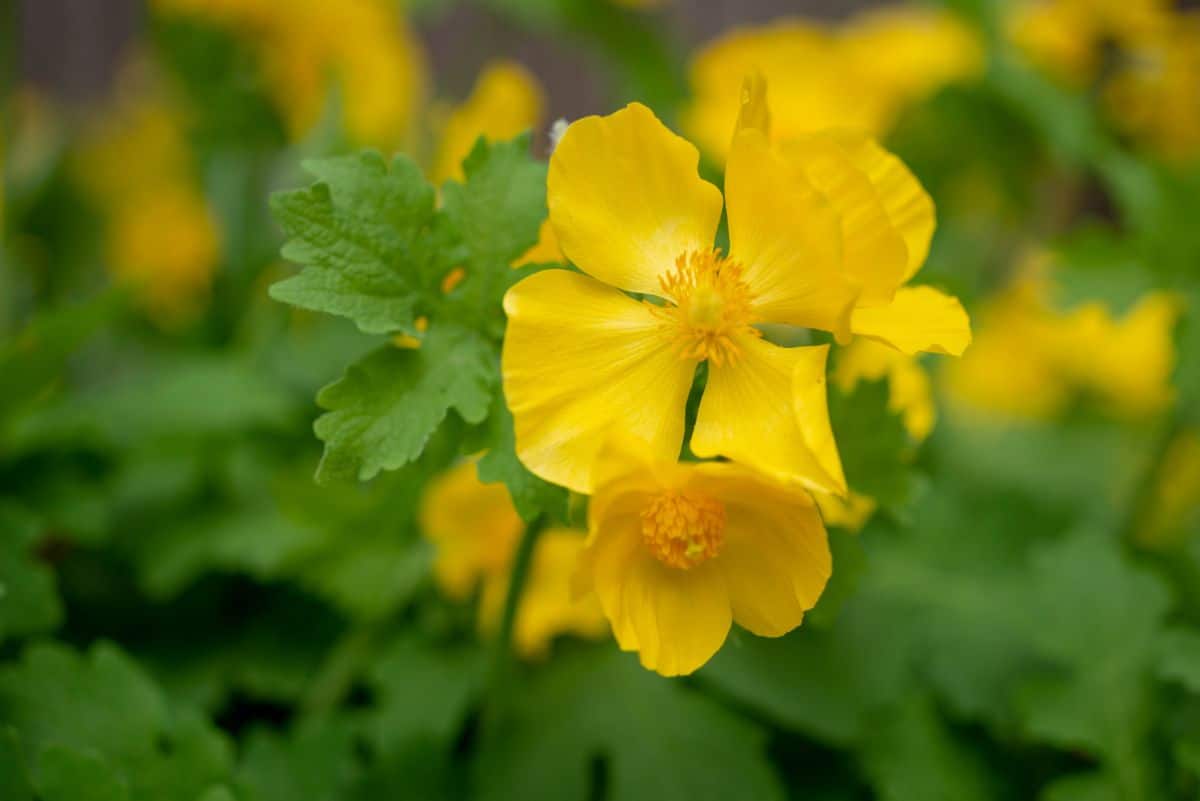
| Plant name: | Celandine poppy |
| Light requirements: | Full sun to part shade |
| Water requirements: | High to moderate |
| Growing zone: | Zones 4 to 9 |
| Recommended against: | Various weeds and grasses |
Also known as the wood poppy, celandine poppies are easy plants to grow in woodland gardens, but they can also tolerate some sun. Prized for their sunny yellow flowers, celandine poppies also have highly ornamental, lobed leaves, which grow as a thick mat over garden soil and suppress weedy growth. When planted en masse, celandine poppies can be used like a groundcover, but these perennials are ornamental enough to keep in flower beds as well.
Compared to some of the other plants on this list, celandine poppies can be relatively slow growers, but once they’re established, these plants are quite reliable. If you don’t deadhead spent flowers, celandine poppies also readily self-sow, which is a great way to get more poppies for your garden! Found throughout eastern North America, celandine poppies make pretty additions to native plant gardens, and their high water tolerance makes them suitable for rain gardens, too!
12. Blue mistflower (Conoclinium coelestinum)
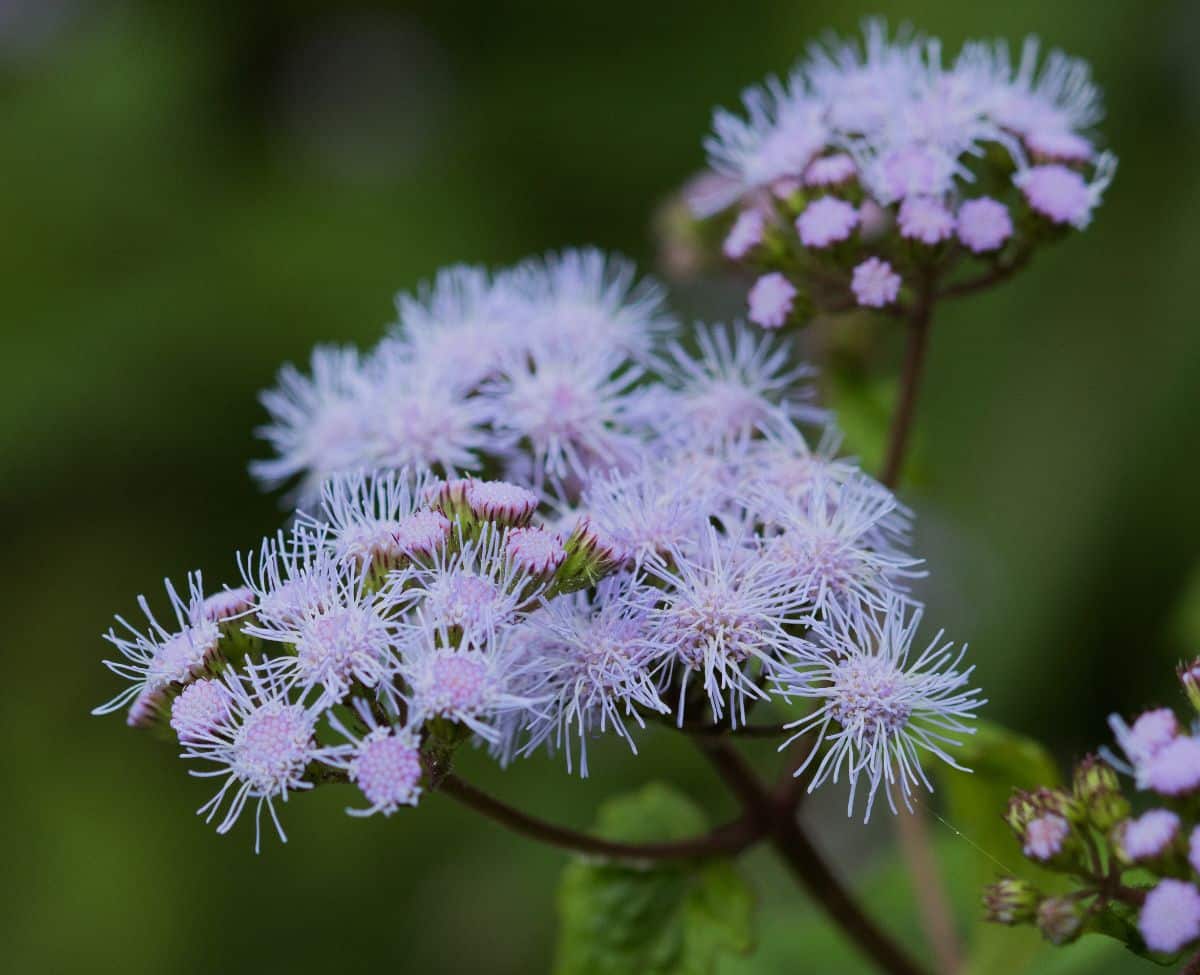
| Plant name: | Blue mistflower |
| Light requirements: | Full sun to part shade |
| Water requirements: | Moderate |
| Growing zone: | Zones 5 to 10 |
| Recommended against: | Various weeds and grasses |
Also known as blue boneset and wild ageratum, blue mistflower is irresistible to pollinators like bees and butterflies, and the plant’s fluffy flowers provide a late source of pollen for insects in autumn. But blue mistflowers are becoming in flower gardens too, and they’re fast growth rate makes them ideal for keeping weeds at bay. In fact, some gardeners are reluctant to sow this plant because it can spread so vigorously!
While blue mistflower does colonize gardens, if you need to keep weeds down, this stately plant can help. Blue mistflower can be grown as border plants or accent plants, but they really come alive when planted together as a no-fuss groundcover. After planting mistflower in your garden, you can allow the plant to spread naturally, or you can propagate the plant intentionally via seeds, root division, or stem cuttings.
13. Pennsylvania sedge (Carex pensylvanica)
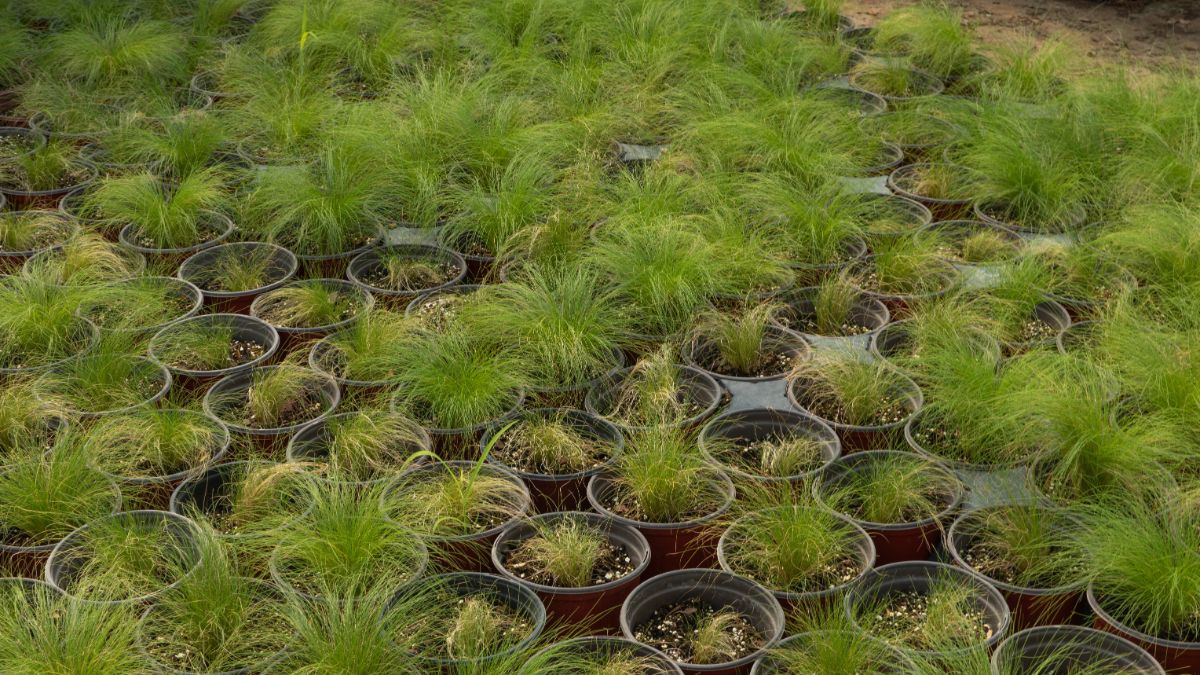
| Plant name: | Pennsylvania sedge |
| Light requirements: | Shade |
| Water requirements: | Moderate |
| Growing zone: | Zones 3 to 8 |
| Recommended against: | Various weeds and grasses |
Despite its name, Pennsylvania sedge is actually native to much of eastern North America, but it can be grown in other locations, and it can survive winters in chilly zone 3. Often grown as a lawn alternative, Pennsylvania sedge is a low-growing, grass-like plant with slender leaves that provide extra texture to landscapes and gardens. Over time, Pennsylvania sedge will grow and spread and fill in areas of bare soil where weeds might otherwise take root.
When fully grown, Pennsylvania sedge only grows to about 8” tall, so if you keep it as a lawn alternative, you can often skip mowing. This plant can be grown on sloping hillsides where lawnmowers are impractical to use, or it can be sown in garden beds to keep invasives out. Naturally deer resistant, Pennsylvania sedge is a tough plant that grows in sandy soils and full to part shade!
14. Wild ginger (Asarum canadense)
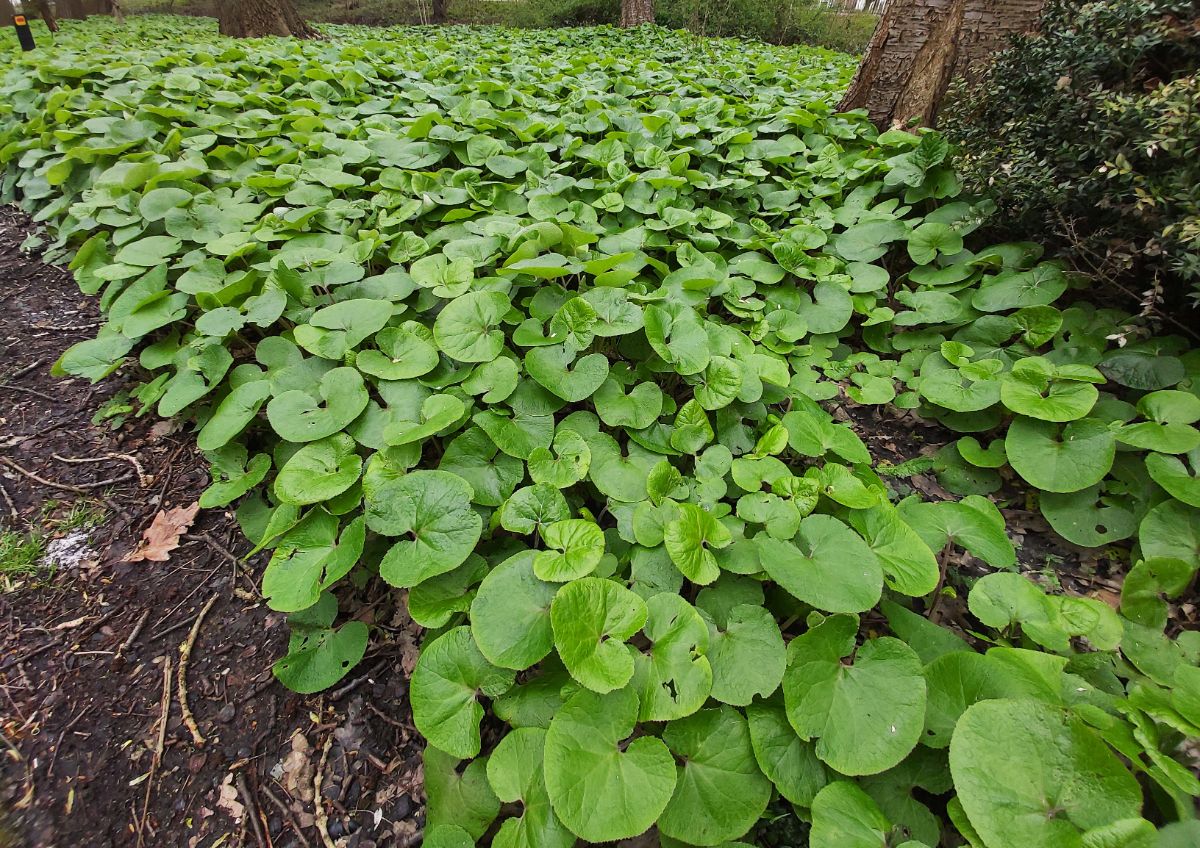
| Plant name: | Wild ginger |
| Light requirements: | Shade |
| Water requirements: | Moderate to low |
| Growing zone: | Zones 3 to 7 |
| Recommended against: | Garlic mustard and other weeds |
Don’t let wild ginger’s name fool you. While this plant may emit a ginger-like aroma when its leaves and stems are crushed, wild ginger is not edible, and it’s not closely related to the ginger root you buy at the grocery store. But that doesn’t mean wild ginger isn’t a useful plant for your garden!
Native to the eastern half of North America, wild ginger is mostly grown as an ornamental groundcover, and its shade tolerance makes it suitable for forest gardens. Prized for its rounded and glossy green leaves, wild ginger has a unique look, and established plants can grow over 8” per year.
When it comes to suppressing weeds, wild ginger is particularly useful against garlic mustard and other low growers, although it’s less useful against tall invasives like Japanese knotweed.
15. Big leaf aster (Eurybia macrophylla)
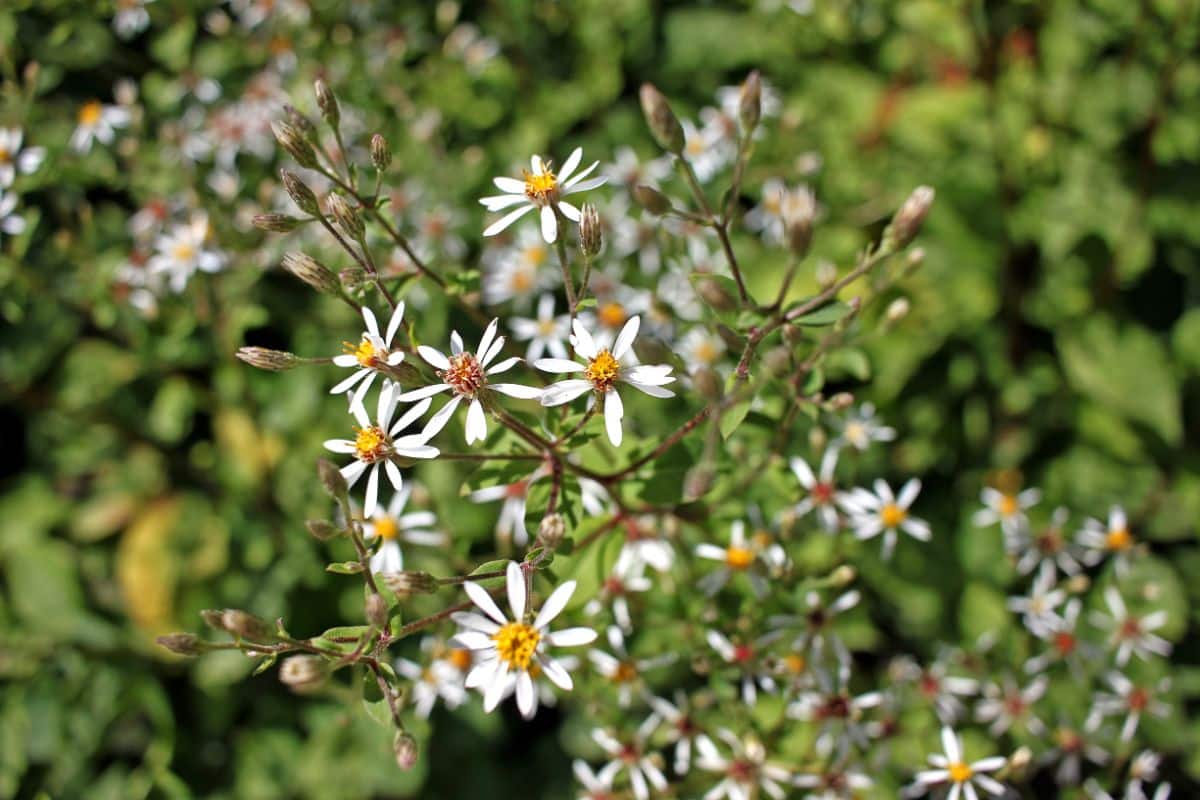
| Plant name: | Big leaf aster |
| Light requirements: | Shade |
| Water requirements: | Moderate to low |
| Growing zone: | Zones 3 to 8 |
| Recommended against: | Garlic mustard and other weeds |
There are many different types of asters that can be used to suppress weeds. But the big leaf aster is particularly beneficial since its broad leaves cover lots of soil space and keep weed seeds from sprouting. Big leaf aster plants can also grow in shade where many types of ornamental groundcovers won’t sprout.
As with most other aster varieties, big leaf aster blooms in late summer to early fall, providing support to pollinators when other food resources are scarce. These plants spread quickly via underground rhizomes, but plants will also self-sow seeds if you don’t deadhead spent blooms. And while you can grow big leaf asters on their own, they look even more alluring if you interplant them with native goldenrods!
16. Northern bush honeysuckle (Diervilla lonicera)
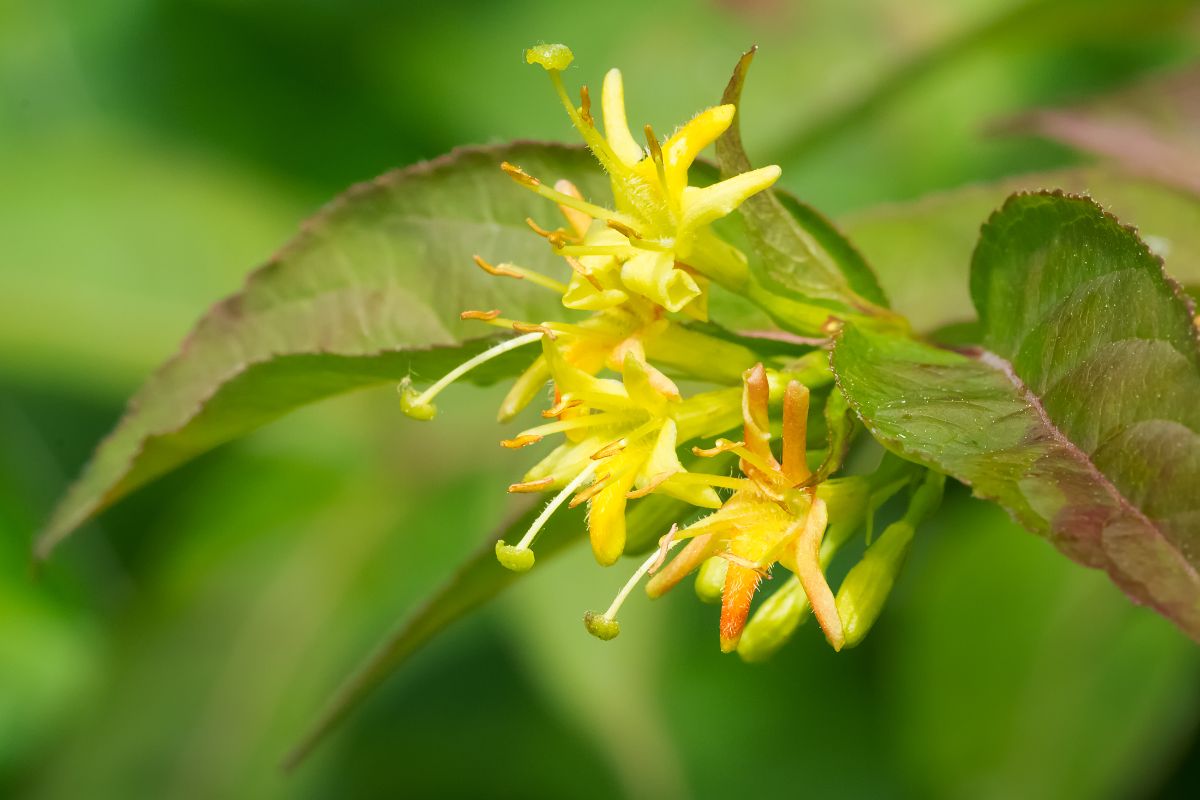
| Plant name: | Northern bush honeysuckle |
| Light requirements: | Full sun to shade |
| Water requirements: | Moderate |
| Growing zone: | Zones 3 to 10 |
| Recommended against: | Various weeds and grasses |
Some honeysuckle plants, like the Japanese honeysuckle, have invasive tendencies, and they choke out ornamentals and native plants. But the northern bush honeysuckle is native to the northeastern United States and Canada, and it can actually combat invasive plants and weeds. Curiously, northern bush honeysuckle isn’t a honeysuckle at all, but it has darling, tubular flowers that are reminiscent of the blooms on true honeysuckle plants.
Part of the reason why northern bush honeysuckle is so good at suppressing weeds is due to the plant’s vigorous and dense growth habit. Although this plant only grows to about 3’ tall, its stems and leaves grow so thickly together that most weeds just can’t compete. Like true honeysuckle plants, the northern bush honeysuckle is highly attractive to pollinators, and it is also a host plant for many pollinator species.
17. Jewelweed (Impatiens capensis)
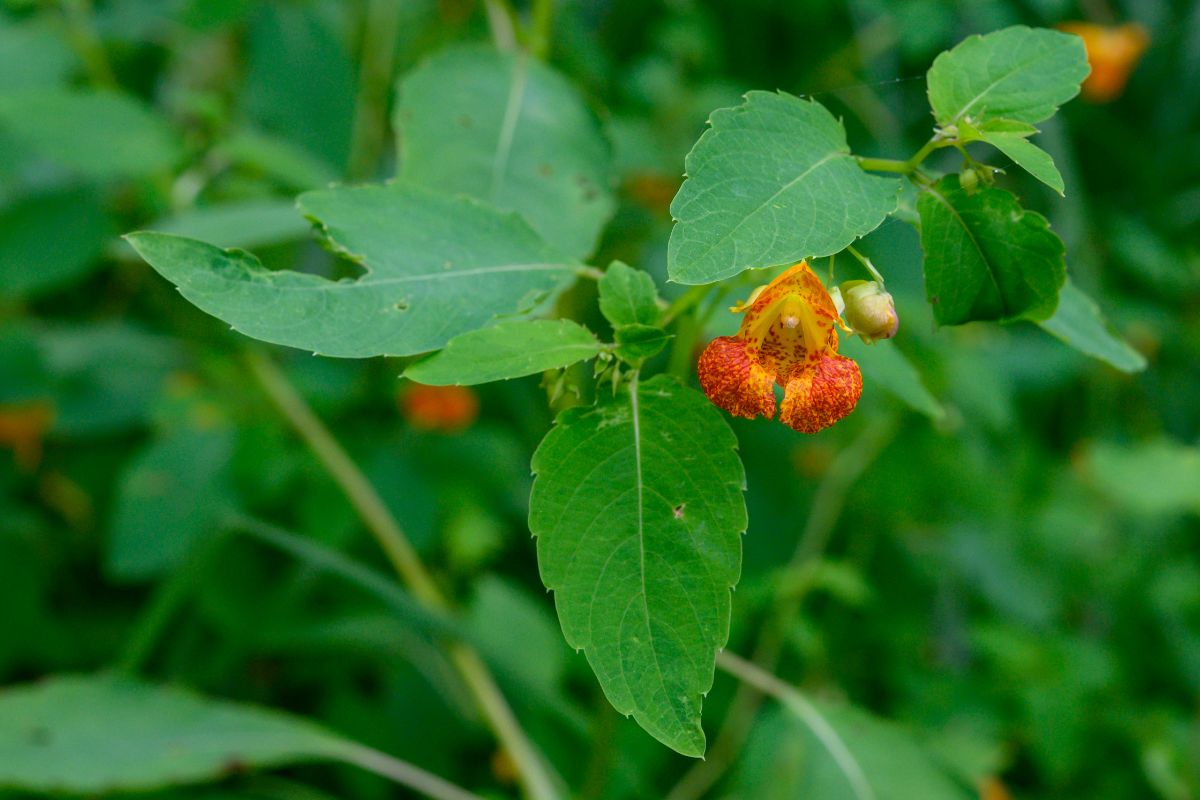
| Plant name: | Jewelweed |
| Light requirements: | Full sun to shade |
| Water requirements: | High |
| Growing zone: | Zones 3 to 10 |
| Recommended against: | Garlic mustard and other weeds |
Ornamental jewelweed is an invasive plant that shouldn’t be intentionally planted in areas where it can grow aggressively. However, orange jewelweed is a native species in North America, and it can often be found growing wild in wetland areas. In the garden, jewelweed is particularly useful in rain gardens and other areas with poorly draining soil.
Also known as the spotted touch me not, jewelweed boasts bright orange, tubular flowers, which are favorite snacking spots for hummingbirds. But these plants are also rapid growers, and they can keep weeds from taking over. Jewelweed plants get their nickname “touch me nots” because their ripe seed pods burst open dramatically with the slightest touch!
18. Goldenrod (Solidago spp.)

| Plant name: | Goldenrod |
| Light requirements: | Full sun to shade |
| Water requirements: | Moderate to low |
| Growing zone: | Zones 2 to 8 |
| Recommended against: | Various weeds and grasses |
Another autumn garden favorite, goldenrod pairs beautifully with asters, and these plants provide a steady source of nectar and pollen for insects late in the season. Goldenrod plants also have tons of ornamental appeal, and their airy, yellow flowers are a bold choice for cut flower arrangements. Not to mention, goldenrod blooms can also be brewed into a homemade natural dye!
Some gardeners are reluctant to plant goldenrod because they associate it with seasonal allergies; however, most allergy symptoms are actually caused by the similar-looking ragweed plant. Goldenrod does grow prolifically through and its fast growth rate makes it an exceptional choice for weed prevention. Depending on your gardening style, you can plan a few goldenrod plants together in an ornamental bed, or you can sow goldenrod plants thickly to create your own mini wildflower field or grass-free alternative lawn!
Summary

Weeds and invasive plants can be difficult to manage, but there’s no reason to reach for chemical herbicides if noxious plants have invaded your garden. Hand pulling, weed barrier fabrics, horticultural vinegar sprays, mulch, and soil solarization are all effective ways to combat weeds naturally. However, even after weeds are removed from your garden, weedy plants are likely to return unless you plant something in that empty soil!
As the old saying goes, “nature abhors a vacuum,” and weeds will grow anywhere where there is a bit of vacant space. But if you keep your garden beds planted with fast-growing native plants, you can ensure that weeds don’t return. And, even better, your garden beds will come alive with all of that stunning native plant color!
If you’d like to learn more techniques for controlling weeds and invasives without chemical herbicides, check out our guide on cover cropping or read up on invasive plants to avoid in garden beds right here.

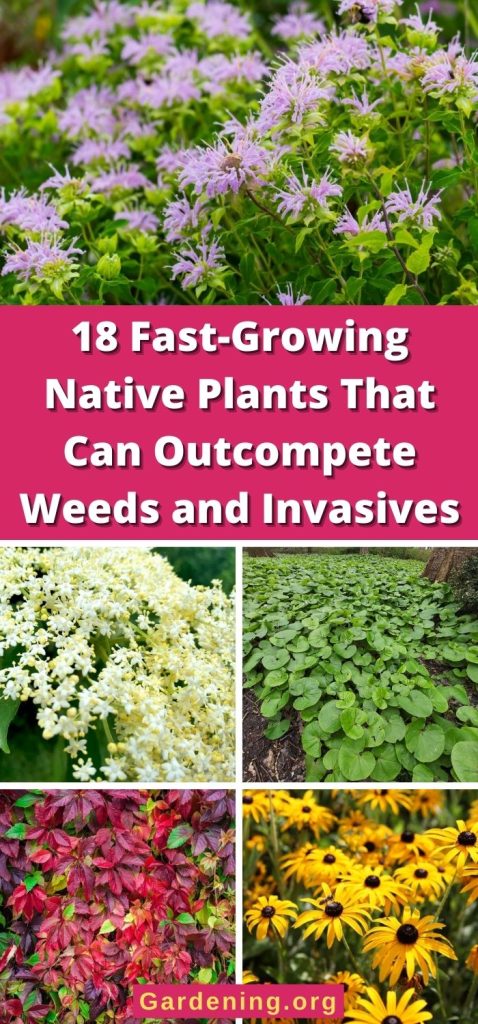
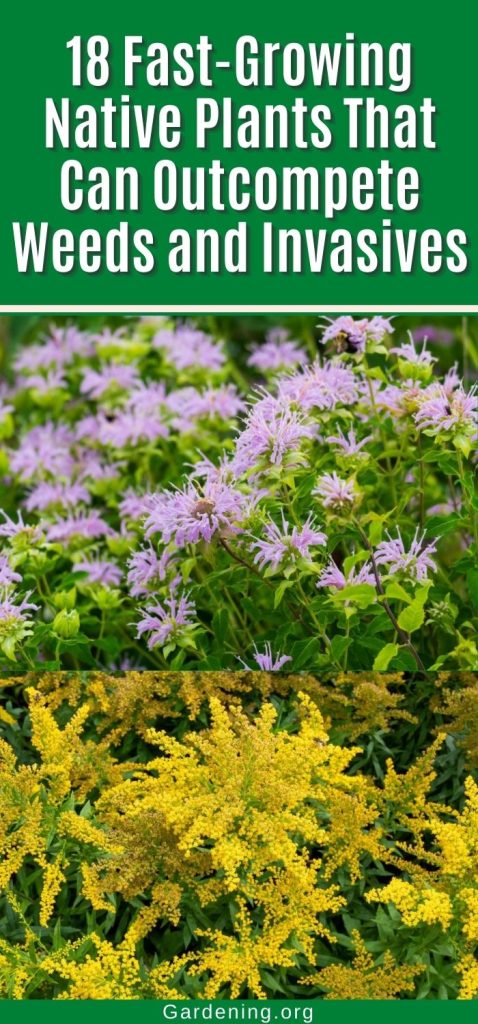
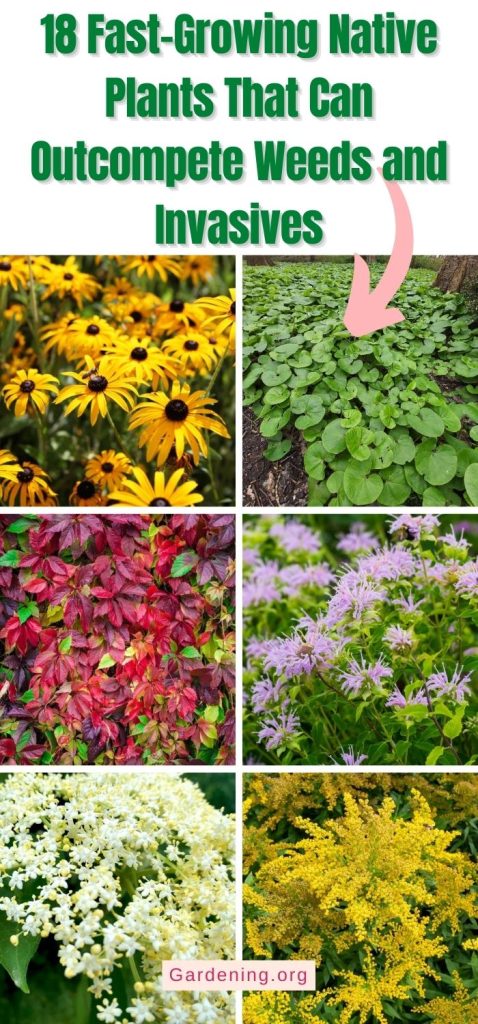
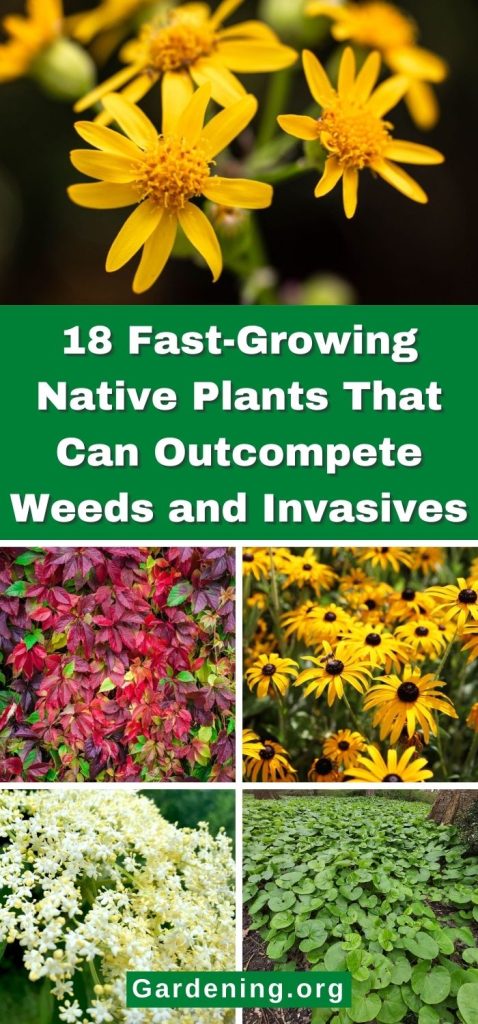

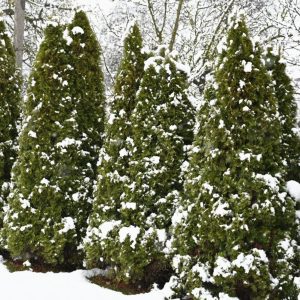


Kit
Good advice
Thanks so much.